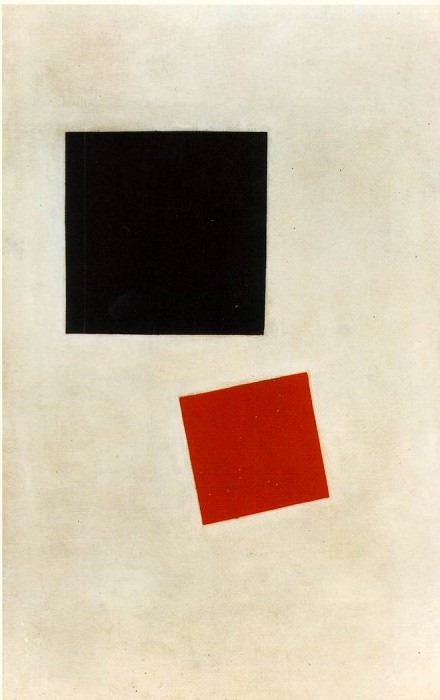Malevitj Black Square and Red Square 1915, Moma NY Kazimir Malevich (1879-1935)
Kazimir Malevich – Malevitj Black Square and Red Square 1915, Moma NY
Edit attribution
Download full size: 653×1039 px (0,0 Mb)
Painter: Kazimir Malevich
To paraphrase Kazimir Malevich, dynamic Suprematism (one of the artist’s movements) is capable of transforming the entire planet, because there are no natures here, only sets of figures symbolizing free flight, impetuous dynamics. And indeed, in the painting we see black and red squares, nothing more. There is no backpack, much less a boy. By the way, the opposite happens with Malevich as well as with other Suprematists: the title is completely abstract, but the image is quite clear, with clearly outlined figures and even images. Whether the freedom of this and other Suprematist paintings is absolute remains debatable.
Description of the painting "Boy with a Backpack" by Kazimir Malevich
To paraphrase Kazimir Malevich, dynamic Suprematism (one of the artist’s movements) is capable of transforming the entire planet, because there are no natures here, only sets of figures symbolizing free flight, impetuous dynamics. And indeed, in the painting we see black and red squares, nothing more.
There is no backpack, much less a boy. By the way, the opposite happens with Malevich as well as with other Suprematists: the title is completely abstract, but the image is quite clear, with clearly outlined figures and even images.
Whether the freedom of this and other Suprematist paintings is absolute remains debatable. The flight that Kazimir talks about is still restricted by something, be it paper or some sort of restraints in the drawing itself. It is no longer complete freedom. Not to mention the fact that the composition is extremely aesthetically pleasing, not far from classical painting. The "trio" of red-white-black is not a classic!
The highlight of this trend is a professional, simply masterful display of Russian souls and minds. Malevich surpasses it and displays in his work the souls and minds not only of Russia, but the whole world!
The composition is austere, but if you draw a mental line from the black square to the red, you can see a clock with a pendulum. To my mind, it looks more like a boy with a satchel, doesn’t it! But there are even those who, coming to Casimir’s exhibition dressed in black with a red backpack, and seeing this painting alive for the first time, call the artist a prophet who predicted the appearance of this very person at the exhibition. Nonsense or not, you are to judge!
It may be through long analysis and research we are yet to understand what is in the head of this boy in black uniform, dragging a red backpack on the way home...
Кому понравилось
Пожалуйста, подождите
На эту операцию может потребоваться несколько секунд.
Информация появится в новом окне,
если открытие новых окон не запрещено в настройках вашего браузера.
You need to login
Для работы с коллекциями – пожалуйста, войдите в аккаунт (open in new window).



















You cannot comment Why?
The painting features two geometric shapes on a beige background. At the top left, a large black square is prominently displayed. Below and to the right of the black square, a smaller red square is positioned at a slight angle, appearing to be tilted. The background is textured and appears to be canvas with subtle variations in tone, creating a sense of depth.
Subtexts: This painting, Black Square and Red Square by Kazimir Malevich, is a seminal work of Suprematism, an abstract art movement that sought to express pure artistic feeling through the use of basic geometric forms.
The black square itself is profoundly symbolic. Malevich described it as an image of the disappearance of things from the world. It can be interpreted as representing the void, the absolute, or the zero point of art, from which new forms could emerge. Its an anti-objective representation, stripping away all discernible subject matter to focus on pure form.
The red square introduces a contrasting element. Red, in art and culture, often symbolizes life, energy, passion, and revolution. Its presence alongside the black square suggests a dynamic interplay between emptiness and existence, between the void and creation. Given the historical context of Russia in 1915, a period of immense social and political upheaval leading up to the Russian Revolution, the red square could also carry connotations of revolutionary spirit and the birth of a new order.
The placement and relationship between the two squares are also significant. The black square, larger and more dominant, is placed higher, while the smaller, tilted red square is below and to the side, suggesting a potential relationship of action or reaction. The tilting of the red square introduces a sense of movement and disequilibrium, contrasting with the stability of the black square.
Overall, the painting can be seen as an exploration of fundamental concepts:
Malevich aimed to create art that was independent of any objective reality, focusing purely on the artists sensations and geometric forms. This painting, with its stark simplicity, challenges viewers to confront pure abstraction and consider the deeper philosophical and emotional meanings embedded within basic shapes and colors.